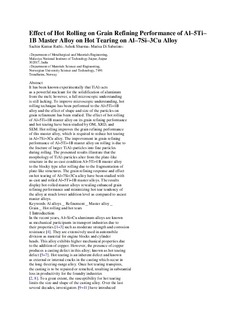| dc.contributor.author | Rathi, Sachin Kumar | |
| dc.contributor.author | Sharma, Ashok | |
| dc.contributor.author | Di Sabatino Lundberg, Marisa | |
| dc.date.accessioned | 2019-04-26T11:22:41Z | |
| dc.date.available | 2019-04-26T11:22:41Z | |
| dc.date.created | 2019-03-07T08:13:42Z | |
| dc.date.issued | 2018 | |
| dc.identifier.citation | Transactions of the Indian Institute of Metals. 2018, 71 (12), 3089-3093. | nb_NO |
| dc.identifier.issn | 0019-493X | |
| dc.identifier.uri | http://hdl.handle.net/11250/2595708 | |
| dc.description.abstract | It has been known experimentally that TiAl3 acts as a powerful nucleant for the solidification of aluminum from the melt; however, a full microscopic understanding is still lacking. To improve microscopic understanding, hot rolling technique has been performed to the Al–5Ti–1B alloy and the effect of shape and size of the particles on grain refinement has been studied. The effect of hot rolling of Al–5Ti–1B master alloy on its grain refining performance and hot tearing have been studied by OM, XRD, and SEM. Hot rolling improves the grain refining performance of this master alloy, which is required to reduce hot tearing in Al–7Si–3Cu alloy. The improvement in grain refining performance of Al–5Ti–1B master alloy on rolling is due to the fracture of larger TiAl3 particles into fine particles during rolling. The presented results illustrate that the morphology of TiAl3 particles alter from the plate-like structure in the as-cast condition Al–5Ti–1B master alloy to the blocky type after rolling due to the fragmentation of plate-like structures. The grain refining response and effect on hot tearing of Al–7Si–3Cu alloy have been studied with as-cast and rolled Al–5Ti–1B master alloys. The results display hot-rolled master alloys revealing enhanced grain refining performance and minimizing hot tear tendency of the alloy at much lower addition level as compared to as-cast master alloys. | nb_NO |
| dc.language.iso | eng | nb_NO |
| dc.publisher | Springer Verlag | nb_NO |
| dc.title | Effect of Hot Rolling on Grain Refining Performance of Al–5Ti–1B Master Alloy on Hot Tearing on Al–7Si–3Cu Alloy | nb_NO |
| dc.type | Journal article | nb_NO |
| dc.type | Peer reviewed | nb_NO |
| dc.description.version | acceptedVersion | nb_NO |
| dc.source.pagenumber | 3089-3093 | nb_NO |
| dc.source.volume | 71 | nb_NO |
| dc.source.journal | Transactions of the Indian Institute of Metals | nb_NO |
| dc.source.issue | 12 | nb_NO |
| dc.identifier.doi | 10.1007/s12666-018-1462-1 | |
| dc.identifier.cristin | 1682761 | |
| dc.description.localcode | This is a post-peer-review, pre-copyedit version of an article published in [Transactions of the Indian Institute of Metals] Locked until 19.11.2019 due to copyright restrictions. The final authenticated version is available online at: https://doi.org/10.1007/s12666-018-1462-1 | nb_NO |
| cristin.unitcode | 194,66,35,0 | |
| cristin.unitname | Institutt for materialteknologi | |
| cristin.ispublished | true | |
| cristin.fulltext | original | |
| cristin.qualitycode | 1 | |
